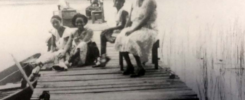Transcript for Episode 1, 2023 Season Talking Hoosier History
“Disguised As A Doughboy:” The Front Line War Work of Sarah M. Wilmer
Written and produced by Jill Weiss Simins
Upon her arrival at the U.S. Army basecamp, elegant entertainer Sarah Mildred Wilmer changed out of her travelling dress and into the brown wool jacket, breeches, and steel helmet of a doughboy. A talented performer and dramatic reader, she had arrived in Bar-le-Due, France, on September 4, 1918, on behalf of the Y.M.C.A. She was recruited to entertain the troops, but within twenty minutes of landing at the camp, she knew she would serve in a different capacity. She disguised herself as a soldier and headed to the front lines under heavy fire to help nurse the wounded. Wilmer would return from France to her parents in Hobart, Indiana, in a wheelchair and celebrated as a hero.
“Aided by friendly officers – entirely outside regulations and unknown to the ‘Y’ man in charge of the base – I would dress in a soldier’s uniform and go up in total darkness.”
When she arrived at the front amidst shelling and gunfire the situation was dire.
I’m Justin Clark and this is Talking Hoosier History.
Born circa 1881 in Buffalo, New York, Wilmer began performing on the circuit of Chautauqua assemblies by 1904. By the time the United States entered WWI, she was nationally renowned and very popular in Indiana, drawing crowds of ten thousand people to her dramatic readings. In 1918, she accepted a request from the YMCA which asked her to go to France through a partnership with the American Expeditionary Forces to entertain the troops and raise their spirits. When she arrived at base camp that September, it became clear that the U.S. forces needed nurses more than entertainers. She volunteered to help, but was told women were not allowed at the front.
I heard a young officer say, “Oh, it’s terrible up there tonight, a lot of the boys have been killed and wounded and there’s not nearly enough men to care for them.”
“Can’t you take me up there?” I asked him.
He told me I was a woman, that it would be breaking the rules.
“Well, get me some man’s clothes and I’ll be a man,” I replied. He hesitated and finally gave me a complete outfit, breeches, blouse, puttees [leg coverings], hobnails [boots] and all. And I went up.
Wilmer went to the front nine times, dressing wounds and comforting dying men. In October she was badly injured by chlorine gas which burned her lungs. But, she said, “I didn’t want to give up.” Though she was back at base camp, she continued to entertain the soldiers with her dramatic readings. This was almost certainly uncomfortable in her condition. On November 11, 1918, she was reading to a large group of men when a colonel walked in and interrupted her to make an announcement. Germany had surrendered. The war was over.
She returned to the United States and to her parents’ home in Hobart, Indiana to recover.
In addition to sharing a story from Indiana history, we’d like to be transparent with you about how we know about the story . . . kind of a look behind the curtain here at IHB. So how did we find out about all of this?
Well, that’s an especially good question in this case because Sarah Wilmer herself liked to weave a good tale. She told slightly different versions of her tale to the Chicago Tribune and then the Lake County Times. We accessed the Times through Hoosier State Chronicles. And you can too! HSC is free and available to the public. We’ll put a link in the show notes to the article we referenced. Wilmer must have realized that the Tribune audience was really interested in the fact that this glamorous entertainer put on the brown wool doughboy uniform in order to help at the front because she played it up a bit when she talked to the Times a few days later.
So, if she improved on her story, why do we trust it? Well, for two main reasons. First, while she ratcheted up the drama of her dressing as a soldier, she remained consistent on the details of battle and her contributions. She gave the credit for heroism to the soldiers who fought and died. She remembered several sacrifices in detail. Second, we used other primary documents, including her passport and ship records to confirm the timing of her trip. We’ll tell you where you can look into all this for yourself in a minute, but let’s finish the story first.
After recovering in Indiana, Wilmer soon went back to entertaining, but the war clearly changed her. She became more and more focused on social work and service to the hearing impaired. When the U.S. entered World War II and women were again called to service, Wilmer answered. She worked a “line job on the graveyard shift” at the local General Motors factory, which had been converted to war production. She also continued her dramatic performances. She died in 1949, and was remembered in her obituary as a “heroine” who “brightened the lives of many” through her social work and dramatic arts. Though only briefly a Hoosier, she is one to remember.
If you want to learn more about Sarah Wilmer, visit the Indiana History Blog to read “Disguised As A Doughboy:” The Front Line War Work of Sarah M. Wilmer by IHB historian Jill Weiss Simins. This episode is based on her article and we’ll put the link in the show notes.
State Historical Markers are also a great way to learn more about Indiana in WWI. Head over to our website in.gov/history and search for the marker for Aaron Fisher. A highly decorated soldier, Fisher was born at Lyles Station in Gibson County. He served as a member of units of the all-Black Buffalo Soldiers before serving on the front lines during WWI with the all-Black 92nd Division. He received the Distinguish Service Cross and the Croix de Guerre for successfully defending his command against German troops despite being wounded.
Women like Sarah Wilmer and Black Hoosiers like Aaron Fisher fought for democracy abroad despite not having equal citizenship at home. IHB is committed to telling these stories through state historical markers, the Indiana History Blog, and right here on the podcast. We hoped you like this short episode, a format we’ll be continuing alongside our longer episodes as well. Let us know! Subscribe, rate, and review us wherever you get your podcasts. Once again, I’m Justin Clark, and this has been Talking Hoosier History. Thanks for listening.
SHOW NOTES
Written and produced by Jill Weiss Simins. Performed by Justin Clark. Research and editing support from Dr. Michella Marino.
This episode is based on the article “Disguised As A Doughboy:” The Front-Line War Work of Sarah M. Wilmer by Jill Weiss Simins. It is available on the IHB website where you can also find notes and sources, along with images: https://bit.ly/3Ozpp3a.



